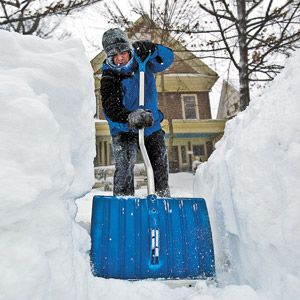
Sure, you’ve got to get rid of that blanket of snow so you won’t fall on your keister on the way to the car, but watch out for another kind of injury: dinging up your driveway’s surface. Before you head out to get your car ready for a trip, check out our handy tips for avoiding premature wear and tear on your driveway. Unless you’re planning to move your car across the country, take your time.
• ASPHALT
Watch Out For: Badly cracked or brittle material. Aggressive shoveling or plowing on an uneven surface can chip off chunks of asphalt.
Best Practices: Keep shovels and snowblower or plow blades at least a half-inch off the surface. If your driveway is badly aged, consider repaving it.
• CONCRETE
Watch Out For: Rock salt used for de-icing. The salt enters through cracks and corrodes the steel reinforcements embedded in the concrete, forcing early replacement.
Best Practices: Use calcium chloride instead, which is less corrosive, and follow package instructions. Seal your driveway every three to five years to protect rebar.
• PAVERS OR BRICK
Watch Out For: Pavers or bricks that protrude from the driveway surface. They can be damaged by the tips of metal shovels or the blades of snowblowers or plows.
Best Practices: Plastic and nonmetal shovels are your best bet for getting rid of snow. And when the thaw comes, tamp down any pavers or bricks that stick up.
• CRUSHED STONE OR GRAVEL
Watch Out For: Above-freezing temps. When snow melts into the surface, getting rid of the icky slush without disturbing the stones is nearly impossible.
Best Practices: Get rid of snow when temps are low, and keep shovels and snowblower or plow blades at least 1 inch off the surface. Place piles of snow in one area so lost stones can be recovered.